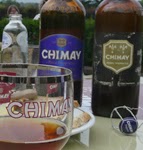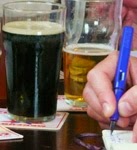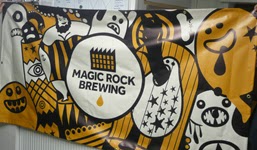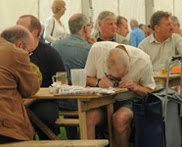World Cup Beer Sweepstake: Paraguay
It's a simple story, really. Once upon a time, in a land far far away, the owner of a flooring company persuaded a maverick brewer to use an aromatic wood that can stop bullets at point blank range to make barrels for aging beer. So let me take you on a journey from the heart of South America's 'Green Hell' to a dining table in a sleepy English village, via the second smallest of the United States. It's the tempestuous relationship between the world's hardest wood, sixteenth best football team and a desperate writer. And it starts in Paraguay.
Having been nominated to write about Paraguay for the World Cup Beer Sweepstake, many of my queries were answered with a question mark. Where exactly was Paraguay? What beers do they brew? What are the populace's personal habits? Are the forests really crammed full of ageing Nazis? My usual degree of in-depth research was called for. Half an hour on Wikipedia and three beers later, I still wasn't much the wiser.
Fortunately, there's always someone on the t'interweb that a desperate writer can turn to. Such as a more successful, wittier, entertaining writer. John Gimlette has travelled extensively throughout South America and his book, 'At The Tomb Of The Inflatable Pig', is probably the definitive travelogue for Paraguay. It's a rollicking good read as he meets "cannibals, Jesuits, Anabaptists, Australian socialists, talented smugglers, dictators and their mad mistresses". And the odd Nazi, obviously. I asked him what he remembered of the beers. "The best beer brewed in Paraguay was Baviera", John told me. He recalled that it was "... very Germanic in its flavour. Given the climate it was always sold very cold". The downtown bars in the capital, Asuncion, served the stuff in foaming Maßkrug; the availability of bratwurst is sadly unrecorded.
That Paraguay should proffer a Germanic lager isn't really unusual. Partly because hot countries and pale lagers are made for each other. Partly because Paraguay has a rich history of European in-migration. The Spanish may have colonised the place but the country has become a haven for Germans, Italians and Russians through the years. So, I had high hopes of securing some kind of lager steeped in European tradition. How hard could it be to find one?
As hard as finding a virgin in Sheffield on a Friday night.
The usual suspects of online retailing had a Paraguayan-shaped hole in their portfolios. Not too surprising, perhaps; why import 'exotic' pale lagers half way around the world when the likes of Brahma, Brazil's finest, is actually brewed in a shed within easy reach of a UK motorway? Emails to the Paraguayan Embassy went unanswered. OK, so lager distribution may not be on the top of their international relations agenda. I was getting even more desperate, which usually leads to one of two things. Either a wallow in the limpid pool of self-pity and anxiety or the development of a plan so cunning you could subtly reword it and pretend you stole it from Edmund Blackadder.
Somebody on Twitter may have suggested it. Certainly, beergenie mentions it. But in my mind's eye, I had a bolt-from-the-blue moment. US brewers Dogfish Head brew a beer called Palo Santo Marron. That beer is aged in a wooden tank. Palo Santo wood. That grows as Palo Santo trees. In the 'Green Hell', Gran Chaco, of... Paraguay. I do believe the popular football phrase is BACK OF THE NET!!!
The backstory of the beer, henceforth to be known as DFHPSM, is worth telling if you've never heard it. John Gasparine, a Baltimore businessman who runs a flooring company, was sourcing woods in Paraguay when he came across bulnesia sarmientoi, known in the country as 'Palo Santo'; holy wood. He noticed how dense it was, heavier than water. That it had natural lubrication from the oils contained within. That it was at the top end of the Janka scale that rates the hardness of wood flooring. So far, so interior design. But Gasparine was attracted by its aromatic quality. And he loved his beer. And he reckoned that a beer aged on Palo Santo wood could be awesome. It would need an awesome brewer to make it happen. But he knew of one - Dogfish Head.
His call to DFH boss Sam Calagione elicited a straightforward reply: "Get a shitload!"
Over four thousand feet of the stuff was needed. That's a lot to cut given that the trees are willowy and three times harder than oak. Would the boards really be strong enough? Gasparine's guide pulled a .38 revolver and shot into a trunk from five feet away. The bullet hardly made a scratch. The order was placed.
The result was a tank over fifteen feet high and ten feet wide with a volume of ten thousand gallons at a cost of $140,000. It was the largest wooden brewing vessel built in the US since Prohibition. "If Dogfish were a publically traded company", said Calagione, "I'd have been fired for this". The 12% brown ale that makes it out the other side is renowned for adopting the caramel-vanilla notes of the Palo Santo wood and so I was looking forward immensely to trying the beer.
As to exactly when and where, I wasn't sure. Paraguay seemed to be fairly handy- silver medalists at the 2004 Olympics and all that - so I was hoping they'd have a good run. They were stocky, plucky, relentless footballers who made the Italians look fairly ordinary. They showed Slovakia how to play the game. They showed New Zealand... well, not a lot, in truth. They dangled Japan onto the end of long balls and the occasional thumping. And so they managed to scrape their way into the quarter finals against Spain, played on the first day of my Norfolk holiday. I believe the popular football phrase is GAME ON!!!
An e-mail reservation was sent to Beers Of Europe for two bottles of DFHPSM, which were picked up on the way through Norfolk. Saturday night was spent with the head of Humpty Dumpty Brewery, Stephen George, and his family at their home in the sleepy Broads village of Reedham. We drank beer. Oh boy, did we drink beer. And I totally forgot about the football. I get like that when I start the evening by drinking 7% IPA. We rolled down the suicidally-steep hill into the river - I mean, into the pub - at some late stage of the evening when the highlights were showing. A ball was billowing the back of the onion bag and I was over-animatedly gesticulating and shouting "WAS THAT PARAGUAY?!?!".
That answer was, er, no. Those old colonialists had done it again. I believe the popular football phrase is SICK AS A PARROT :-(
Let's look on the bright side. Throughout the World Cup, Paraguay proved to be handy at the long ball (476 passes, more than Brazil, fifth highest overall) and keeping on the move (550 km, sixth highest overall) which was only tempered slightly by the number of fouls they committed (third highest, more than Spain) and handballs (third highest once again). Victor Caceres proved to be so popular with referees that he was the most booked player in the tournament. But losing out to the eventual winners is something that the founding father of Paraguayan football, a Dutch sports instructor called William Paats, would surely have been proud of.
And there's always the beer. Stacks of tobacco, cherry, chocolate, spices and that vanilla-caramel-boozy-pudding feeling. There's a hell of a lot of flavour packed in there. Like those footballers, it's a stocky little thing that punches above its weight and proves to be as hard as nails.
The last words have to be in Guarani, the indigenous language of Paraguay. It's claimed that up to 90% of the population understand it - which is gobsmacking given their ethnic and cultural diversity. There's no letter W. Y is a vowel sound. And all you need to know about it, me and DFHPSM that night is:
Tuicha oka'u. Che ha'u; Che ka'u.
(Very drunk. I drink; I'm a drunk)
Having been nominated to write about Paraguay for the World Cup Beer Sweepstake, many of my queries were answered with a question mark. Where exactly was Paraguay? What beers do they brew? What are the populace's personal habits? Are the forests really crammed full of ageing Nazis? My usual degree of in-depth research was called for. Half an hour on Wikipedia and three beers later, I still wasn't much the wiser.
Fortunately, there's always someone on the t'interweb that a desperate writer can turn to. Such as a more successful, wittier, entertaining writer. John Gimlette has travelled extensively throughout South America and his book, 'At The Tomb Of The Inflatable Pig', is probably the definitive travelogue for Paraguay. It's a rollicking good read as he meets "cannibals, Jesuits, Anabaptists, Australian socialists, talented smugglers, dictators and their mad mistresses". And the odd Nazi, obviously. I asked him what he remembered of the beers. "The best beer brewed in Paraguay was Baviera", John told me. He recalled that it was "... very Germanic in its flavour. Given the climate it was always sold very cold". The downtown bars in the capital, Asuncion, served the stuff in foaming Maßkrug; the availability of bratwurst is sadly unrecorded.
That Paraguay should proffer a Germanic lager isn't really unusual. Partly because hot countries and pale lagers are made for each other. Partly because Paraguay has a rich history of European in-migration. The Spanish may have colonised the place but the country has become a haven for Germans, Italians and Russians through the years. So, I had high hopes of securing some kind of lager steeped in European tradition. How hard could it be to find one?
As hard as finding a virgin in Sheffield on a Friday night.
The usual suspects of online retailing had a Paraguayan-shaped hole in their portfolios. Not too surprising, perhaps; why import 'exotic' pale lagers half way around the world when the likes of Brahma, Brazil's finest, is actually brewed in a shed within easy reach of a UK motorway? Emails to the Paraguayan Embassy went unanswered. OK, so lager distribution may not be on the top of their international relations agenda. I was getting even more desperate, which usually leads to one of two things. Either a wallow in the limpid pool of self-pity and anxiety or the development of a plan so cunning you could subtly reword it and pretend you stole it from Edmund Blackadder.
Somebody on Twitter may have suggested it. Certainly, beergenie mentions it. But in my mind's eye, I had a bolt-from-the-blue moment. US brewers Dogfish Head brew a beer called Palo Santo Marron. That beer is aged in a wooden tank. Palo Santo wood. That grows as Palo Santo trees. In the 'Green Hell', Gran Chaco, of... Paraguay. I do believe the popular football phrase is BACK OF THE NET!!!
The backstory of the beer, henceforth to be known as DFHPSM, is worth telling if you've never heard it. John Gasparine, a Baltimore businessman who runs a flooring company, was sourcing woods in Paraguay when he came across bulnesia sarmientoi, known in the country as 'Palo Santo'; holy wood. He noticed how dense it was, heavier than water. That it had natural lubrication from the oils contained within. That it was at the top end of the Janka scale that rates the hardness of wood flooring. So far, so interior design. But Gasparine was attracted by its aromatic quality. And he loved his beer. And he reckoned that a beer aged on Palo Santo wood could be awesome. It would need an awesome brewer to make it happen. But he knew of one - Dogfish Head.
His call to DFH boss Sam Calagione elicited a straightforward reply: "Get a shitload!"
Over four thousand feet of the stuff was needed. That's a lot to cut given that the trees are willowy and three times harder than oak. Would the boards really be strong enough? Gasparine's guide pulled a .38 revolver and shot into a trunk from five feet away. The bullet hardly made a scratch. The order was placed.
The result was a tank over fifteen feet high and ten feet wide with a volume of ten thousand gallons at a cost of $140,000. It was the largest wooden brewing vessel built in the US since Prohibition. "If Dogfish were a publically traded company", said Calagione, "I'd have been fired for this". The 12% brown ale that makes it out the other side is renowned for adopting the caramel-vanilla notes of the Palo Santo wood and so I was looking forward immensely to trying the beer.
As to exactly when and where, I wasn't sure. Paraguay seemed to be fairly handy- silver medalists at the 2004 Olympics and all that - so I was hoping they'd have a good run. They were stocky, plucky, relentless footballers who made the Italians look fairly ordinary. They showed Slovakia how to play the game. They showed New Zealand... well, not a lot, in truth. They dangled Japan onto the end of long balls and the occasional thumping. And so they managed to scrape their way into the quarter finals against Spain, played on the first day of my Norfolk holiday. I believe the popular football phrase is GAME ON!!!
An e-mail reservation was sent to Beers Of Europe for two bottles of DFHPSM, which were picked up on the way through Norfolk. Saturday night was spent with the head of Humpty Dumpty Brewery, Stephen George, and his family at their home in the sleepy Broads village of Reedham. We drank beer. Oh boy, did we drink beer. And I totally forgot about the football. I get like that when I start the evening by drinking 7% IPA. We rolled down the suicidally-steep hill into the river - I mean, into the pub - at some late stage of the evening when the highlights were showing. A ball was billowing the back of the onion bag and I was over-animatedly gesticulating and shouting "WAS THAT PARAGUAY?!?!".
That answer was, er, no. Those old colonialists had done it again. I believe the popular football phrase is SICK AS A PARROT :-(
Let's look on the bright side. Throughout the World Cup, Paraguay proved to be handy at the long ball (476 passes, more than Brazil, fifth highest overall) and keeping on the move (550 km, sixth highest overall) which was only tempered slightly by the number of fouls they committed (third highest, more than Spain) and handballs (third highest once again). Victor Caceres proved to be so popular with referees that he was the most booked player in the tournament. But losing out to the eventual winners is something that the founding father of Paraguayan football, a Dutch sports instructor called William Paats, would surely have been proud of.
And there's always the beer. Stacks of tobacco, cherry, chocolate, spices and that vanilla-caramel-boozy-pudding feeling. There's a hell of a lot of flavour packed in there. Like those footballers, it's a stocky little thing that punches above its weight and proves to be as hard as nails.
The last words have to be in Guarani, the indigenous language of Paraguay. It's claimed that up to 90% of the population understand it - which is gobsmacking given their ethnic and cultural diversity. There's no letter W. Y is a vowel sound. And all you need to know about it, me and DFHPSM that night is:
Tuicha oka'u. Che ha'u; Che ka'u.
(Very drunk. I drink; I'm a drunk)





















excellent stuff, this is one of my fave sweep posts!
ReplyDeleteAgreed, this must be the best 9albeit 4 days late) BWCS blog yet!
ReplyDeleteI was hugely impressed with Palo Santo Marron, one of the finest bottled beers I've had for a long time, massive range of flavours from chestnuts (hence the name, obviously) to curacao oranges, with the vanillas from the wood nothing like the frankly rather crude oakey aromas found in something like Innis & Gunn. Bloody expensive, though …
ReplyDeleteI am hugely uninterested in wood-flavoured beers, but even I want to try this.
ReplyDelete